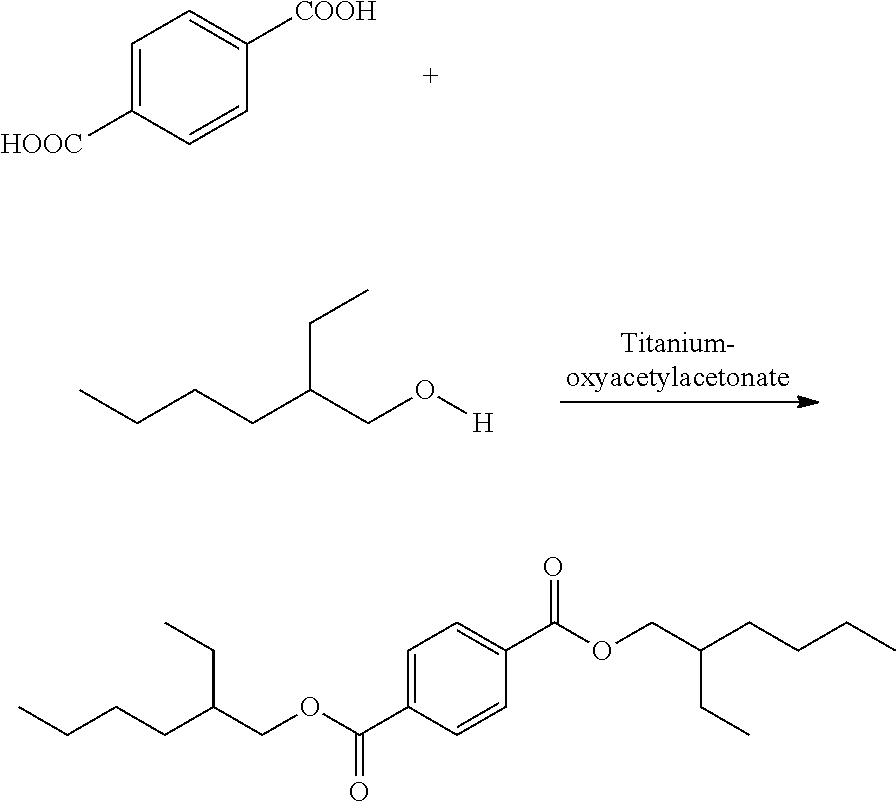Method of making dialkyl terephthalate from terephthalic acid
a technology of terephthalic acid and dialkyl terephthalate, which is applied in the field of dialkyl terephthalate manufacturing, can solve the problems of only converting about 80-90% of tpa, and the market demand is shrinking
- Summary
- Abstract
- Description
- Claims
- Application Information
AI Technical Summary
Benefits of technology
Problems solved by technology
Method used
Image
Examples
example 1
Esterification of Terephthalic Acid (TPA) with 2-ethylhexanol (2-EH)
[0034]Esterification of TPA with 2-EH is in accordance with Scheme 1.
[0035]The following general procedure was used. To a four-neck round bottom flask equipped with a mechanical / magnetic stirrer, Dean-Stark apparatus, and a thermometer pocket for monitoring internal temperature, 100 g TPA and 3.5 equivalents (eq) of 2-EH were added with agitation. The mixture was heated over an oil bath with a set temperature of 210° C. The titanium catalyst was added when the internal temperature was 170° C. The quantity of catalyst varied from 0.11 mol % to 0.22 mol % with respect to TPA. After catalyst addition, slow formation of water was observed. The water formed during the reaction was collected in the Dean-Stark apparatus and drained out from time to time from the layer-separated mixture of water and 2-EH. The reaction was continued for 24 hours and then filtered. Conversion of TPA was determined by filtering the solids (unr...
example 2
Isolation of Dioctyl Terephthalate (DOTP)
[0037]The filtrate of Example 1 was cooled to below 100° C. and set for a distillation to remove excess 2-EH. After setting the vacuum at 7 to 8 mbar, the temperature of the reaction mixture was slowly raised in the following sequence: 130 to 150 to 200 to 210° C., to remove most of the 2-EH. The mixture cooled back to 90° C. and 1 ml of aqueous caustic (NaOH) solution (49%, w / v) and 2 ml water were added to the mixture and stirred for 30 to 40 min Excess caustic was neutralized by purging in-situ generated CO2 in the reaction mixture for 20 to 30 min. Then the mixture was again distilled to remove water and the rest of the 2-EH following the previous distillation method.
[0038]The mixture was cooled to 120° C. and filtered over 1 g CELITE (1 wt % on the basis of the weight TPA used in the reaction) to remove the white solid (residual sodium salt of TPA and carbonate salt and Titanium salt) resulting in a viscous liquid. The liquid was treated...
PUM
| Property | Measurement | Unit |
|---|---|---|
| temperature | aaaaa | aaaaa |
| molar ratio | aaaaa | aaaaa |
| pressure | aaaaa | aaaaa |
Abstract
Description
Claims
Application Information
 Login to View More
Login to View More - R&D
- Intellectual Property
- Life Sciences
- Materials
- Tech Scout
- Unparalleled Data Quality
- Higher Quality Content
- 60% Fewer Hallucinations
Browse by: Latest US Patents, China's latest patents, Technical Efficacy Thesaurus, Application Domain, Technology Topic, Popular Technical Reports.
© 2025 PatSnap. All rights reserved.Legal|Privacy policy|Modern Slavery Act Transparency Statement|Sitemap|About US| Contact US: help@patsnap.com

